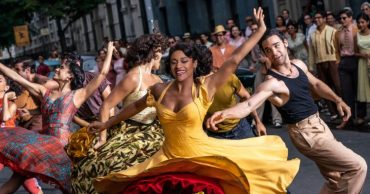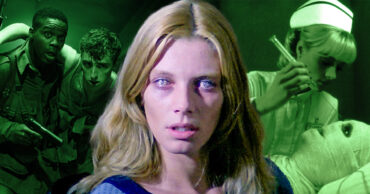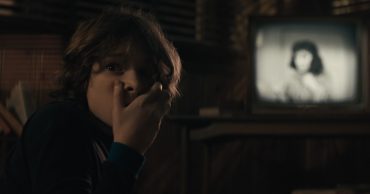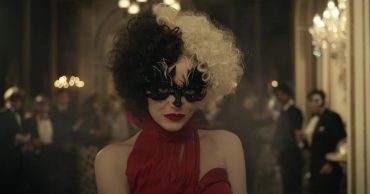
The year 1928 witnessed the installation of the first few test television sets in New York, the patenting of the first automatic photographic film developing machine, the discovery of human fossils that led to the term ‘Homo Erectus, the first solo flight between England and Australia, the debut of Mae West’s daring play Diamond Lil, the first time bread sliced by a machine was sold, and the creation of the first test footage for Walt Disney’s Steamboat Willie featuring Mickey Mouse, and more. Of course, to add to this list of happenings were the many movies that saw the light of day and opened to audiences throughout the year. From the historic The Passion of Joan of Arc to Charlie Chaplin’s The Circus, there were so many impressive titles to choose from if it was a night out at the movies you sought. And to make the choice even easier, here we are with our list, What A Night Out At The Movies In 1928 Would Have in Store For You!
The Passion of Joan of Arc
The Passion of Joan of Arc, La Passion de Jeanne d’Arc in French, was one of the most celebrated movies in 1928 and was a highly important work in the silent era as it was based on the actual happenings of the trial of Joan of Arc. Directed by Carl Theodor Dreyer, the film had Renee Jeanne Falconetti playing the historical character of Joan of Arc, a role she would come to be defined by throughout her career and her life, with Eugene Silvain, Andre Berley, and Maurice Schutz, playing other important roles. The film itself was made with painstaking effort and attention to detail, with the director first spending more than a year conducting research and going through transcripts related to Joan of Arc and only then getting down to writing the script with Joseph Delteil. Even the filmmaking process was different. Dreyer did not allow any of the artists to weak any makeup and the filming was done in a huge concrete and highly detailed set that was specially built in line with the architectural intricacies of the time. From digging holes to capture low-angle shots to painting the entire set pink so that it appears grey in the black and white film used during the era, The Passion of Joan of Arc stands testimony to the immense attention to detail that was necessary at a time when technology was limited. However, the passion behind the project made it one of the most refined and popular works of the silent era.
The Cameraman
Starring the inimitable Buster Keaton and directed by Edward Sedgwick, with Buster also doubling up as uncredited co-director, The Cameraman was the highly successful leading man’s first film with MGM, a move that backfired only a year later with him calling it “the worst mistake” of his career. Anyway, as far as this movie was concerned, it did manage to make the right kind of waves! Beginning with the premise of a small-time portrait photographer falling in love with a secretary who works for MGM Newsreels and moves on to the adventures that Buster was well-known for, and of course, at the end of it all, winning over the girls of his dreams in the most impish of ways possible. A hit with audiences as well as critics, The Cameraman was especially noted for how well it was written, and in fact, the studio even used the script of the film as the perfect example of how a comedy should be written. Once considered lost, it was only in 1968 that a print of the film was rediscovered, followed by another high-quality one in 1991, following which a new print was created by merging the best of the two. Well, we sure are glad to see that we did not lose yet another brilliant piece of cinematic work to the pages of history!
The Wind
Lilian Gish, Lars Hanson, Montagu Love, and Dorothy Cumming, get together their talents in this romantic drama from the silent era — The Wind. The film has a young and hopeless woman traveling to Texas to try and find a reason to live and after one heartbreak that follows another is married to someone who she thinks is the wrong man for her. Soon, however, she realizes that she was wrong and things play out in such a way that she even ends up murdering one of her previous suitors during the course of her life towards this realization. Directed by Victor Sjostrom, the film has been woven together beautifully to include the windy and almost storm-like conditions that prevail in the arid and dry expanses of Texas, and throughout the film, the wind has been shown to play a major role. Only one of the many beautiful additions to the storyline and picturization of the film, these elements add up to make The Wind a beautiful story indeed.
Laugh, Clown. Laugh
The title of this particular film may have had the words laugh and clown in them but if audiences went into the theaters looking for a few laughs, they would instead be greeted with a highly emotional storyline that made this silent drama one of the most endearing works of the year 1928. Starring Lon Chaney and Loretta Young, the film begins with the adoption of an abandoned girl by a traveling circus clown, and how the relationship evolves into something different. At the end of it all, however, is terrible heartbreak, so if you had to choose to watch this movie on one of your night-outs in 1928, you would have surely walked out of the theater wiping tears away from your eyes. Showing the complications and intricacies of human relationships as well as the melancholy and happiness that arise from both, Laugh, Clown, Laugh is an emotional tale that leaves you with tears and heartbreak, but also with life lessons.
The Circus
As was the case with most of Charlie Chaplin’s works, The Circus too had him donning the roles of director, writer, producer, and of course, lead actor. Yet another film that proved the unnatural command that Charlie Chaplin had on just about everything to do with filmmaking, and of course, once again merging the elements of tragedy and comedy, this one was one of the biggest hits of the silent era, raking in a whopping and record-breaking $3.8 million at the worldwide box office. The film’s storyline has a hungry and impoverished tramp joining a circus in the hope of employment and ready meals and thereby affecting just about everyone’s lives with his antics and adventures. With memorable and extraordinary scenes such as his time inside a lion’s cage as well as the action sequences on the trapeze, the film was a hilarious ride indeed, making The Circus one of those movies that audiences returned to theaters to watch more than once. So if you were to choose this one for a night out at the movies in 1928, you would surely find yourself heading back for more!
The Man Who Laughs
A silent romantic drama with Mary Philbin, Conrad Veidt, Brandon Hurst, Cesare Gravina, Stuart Holmes, Samuel de Grasse, George Siegmann, Josephine Crowell, and others leading the way as cast members and Paul Leni donning the director’s chair, The Man Who Laughs was based on Victor Hugo’s written work by the same name. Based on the drama surrounding the lives of Dea, Gwynplaine, and Barkilphedro, and all this set in the 17th century, the film is also depicted as a work of horror representing the German Expressionist era. With a high emotional quotient and elements that were a departure from the usual ones that were explored by filmmakers during the time, although critical appreciation was a hard time coming when the film was released, the work has emerged as a truly pathbreaking one as time has gone by. The film and its characters have also had an impact on future filmmakers and actors, with the infamous grin of the character of The Joker (the popular yet dangerous villain from the Batman franchise) said to be inspired by Conrad Veidt’s portrayal of Gwynplaine. Of course, you wouldn’t have known all this if you had to walk into a theater to watch The Man Who Laughs back in 1928. All you’d see was a piece of cinematic brilliance!
The Crowd
Romance has always been an important element in the art of filmmaking and there have been thousands of films that have explored the emotions and adventures behind a good romantic story through the decades, and the year 1928 was no different. One of the romantic movies of the year that won over audiences was The Crowd. Directed by King Vidor and starring James Murray, Eleanor Boardman, and Bert Roach in the lead roles, the film was based on a story by King Vidor and Harry Behn, although the latter remained uncredited. A beautiful story that begins with the love and marriage of two beautiful people and then moves on to depict the complications that usually arise in any marriage, the plot then moves to absolute heartbreak when the young couple loses their little girl to a truck accident. With the depression that seeks in and a string of jobs that do not work out, it seems like all is lost for the young father. However, with the love the man has for his son and wife, as well as the extraordinary commitment and faithfulness of the woman backing them up, the family decides to overcome their hard times and are last seen enjoying a vaudeville comedy show. Playing out in New York, The Crowd was also a huge draw for its scenes of the city, and of course, a peek into the challenges it brings.
The Docks of New York
The Docks of New York is a romantic drama with its own share of love, adventure, excitement, heartbreak, and even murder, and proved to be quite the story that enthralled audiences in 1928. With George Bancroft as Bill Roberts, Betty Compson as Mae, Olga Baclanova as Lou, Clyde Cook as “Sugar” Steve, Mitchell Lewis as Andy, and Gustav von Seyffertitz as “Hymn Book” Harry, the film revolves around the visit of sailors of a tramp steamer to a local dance-hall saloon in New York City, and all that then transpires. From falling head over heels to abandonment and then returning to the saving of another woman’s life and dignity if it meant murdering one’s ex-husband, there’s a lot that goes on in the film, giving audiences a fair share of highs and lows and of course, a peek into the lives of those who are forced to choose lives they would never otherwise live, all due to the tragedy that is poverty. The wedding scene from The Docks of New York was particularly noted for its impactful picturization and details, while the movie itself was not just a hit with audiences of the time but also continues to win over the hearts of those who watch it even today.
The Patsy
Yet another film from King Vidor‘s stables, The Patsy is a comedy-drama from the silent era and was one of the most renowned films of his career, even played out at the Berlin International Film Festival when celebrating the late filmmaker’s career in February 2020. Starring Marion Davies playing the role of Patricia Harrington and Marie Dressler playing the role of Ma Harrington, the film is one of the most revered films of the silent era and has been tagged a classic. A project that had the director encouraging the talented Marion Davis “let loose” and get into as many antics as she could to get her comedic side out into the open, the film has some amusing and heartfelt moments where the actress is seen doing just that. In the first of Marion’s collaborations with King Vidor, the audiences loved everything she did in the movie and her portrayal of Patricia was one of the main reasons behind the immense success the movie enjoyed. Labeled “progressive” among other things, The Patsy was a Marion Davies project all the way!
Lonesome
One of the first films from the silent era to experiment with and integrate the technology that enabled part of it to be produced as a talkie, Lonesome is a comedy-drama written by Tom Reed and Edward T. Lowe Jr. and based on a story by Mann Page. Directed by Paul Fejos, the film stars Barbara Kent and Glenn Tryon. A beautiful story that plays out mostly over the course of a single day, the film has two lonely souls, Mary, played by Barbara, and Jim, played by Glenn, in New York City who live boring and monotonous lives. On their day off, the two separately decide to visit Coney Island during the Independence Day weekend and bump into each other. As the day progresses, they realize that they truly enjoy each other’s company and as the hours go by, it is clear to the audience that a love story is in the works. However, a mishap on the Cyclone rollercoaster and then a rainstorm throws things haywire and separates them for the day. What’s even more heartbreaking is that the two hadn’t really shared any details about one another until then, which means that there was no way that the two could now get in touch. As the hero and the heroine of the saga go back to their lonely lives in their respective homes, the audience is able to feel the despair in the air too. However, all is well soon enough when the duo realizes that they have been neighbors in the same apartment building all along and it was only fate playing tricks on them before getting them back into each other’s arms! All in all, Lonesome does make for a beautiful story and is especially endearing as it is set against the even more romantic backdrop of the silent and black & white era!
That’s What A Night Out At The Movies In 1928 Would Have in Store For You!
With a host of romantic dramas and comedies to dark thrillers, this list of movies from 1928 is indeed the best of the lot that could have come your way if you were hunting for a night out at the movies way back in time. Of course, while the romanticism of the black & white era would have made your experience even more heartwarming, there is no denying that the brilliance of filmmaking even during these early times in cinema would have left you impressed. On our part, we sure hope you found several reasons to enjoy this list called What A Night Out At The Movies In 1928 Would Have in Store For You that we specially put together for the film aficionado in you!
 Follow Us
Follow Us






This article says The Passion of Joan of Arc was “based on the actual happenings of the trial of Joan of Arc”, which has been disputed by historians because the trial transcript (which the movie was based on) was later denounced by many of the tribunal members after the war: they said it was falsified on important points, and they gave detailed descriptions of what actually went on at the trial. The film therefore is not terribly accurate on some points. Also, I don’t think audiences saw it in 1928 because the original cut of the film was destroyed in a fire almost immediately after completion, and a second cut also met disaster. A copy was later found in the 1980s (I think it was) and became a cult classic among film buffs, but I don’t think anyone in the 1920s actually saw it in theaters.